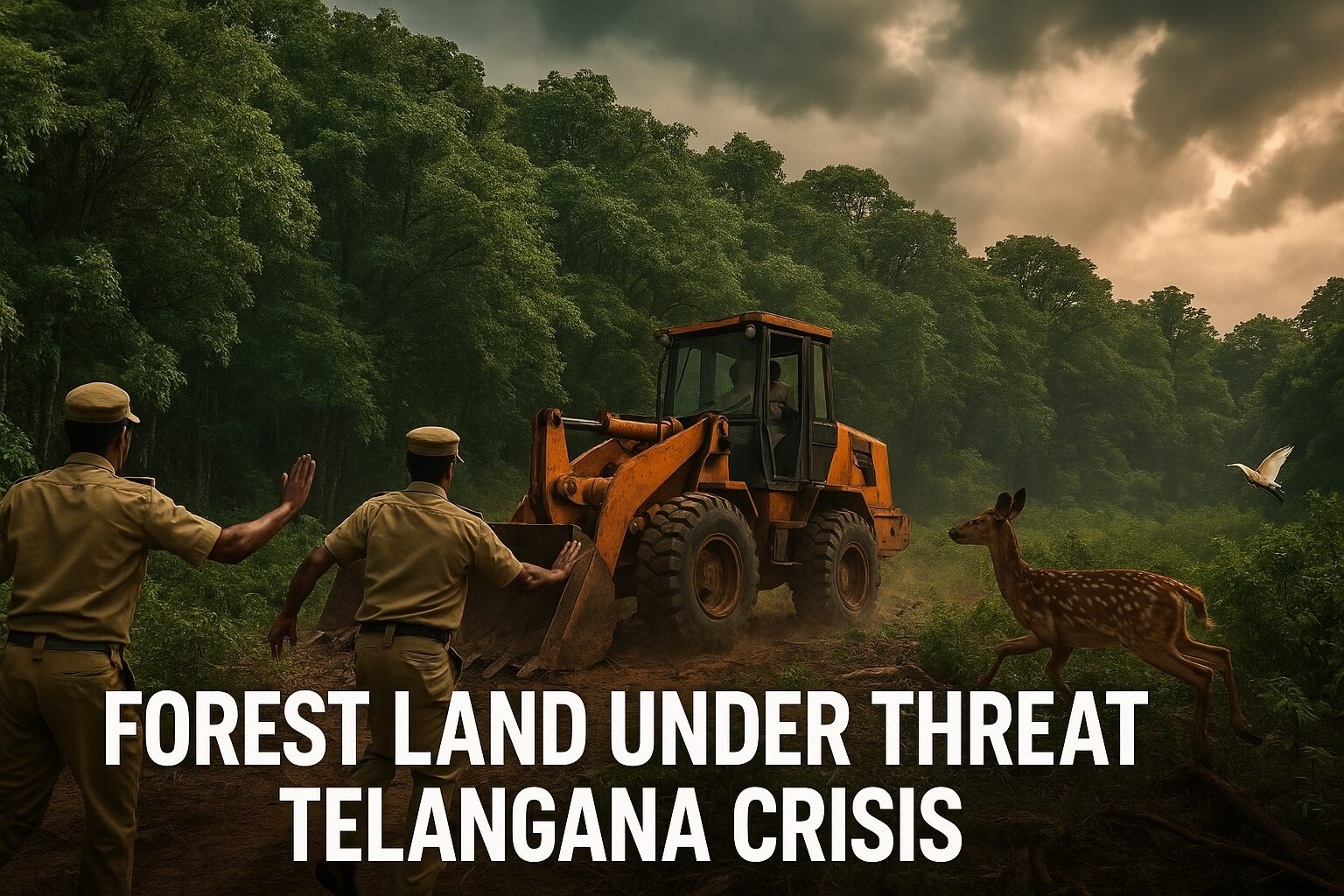The ongoing Hyderabad Forest Case and forest land dispute in Hyderabad has sparked significant worries regarding the preservation of our natural resources. What began as individual accounts of intrusions has transformed into a significant environmental and legal crisis, encompassing vast stretches of valuable forest land, governmental measures, and rising assaults on forest personnel.
Let’s analyze the situation, identify the parties involved, understand the reasons behind it, and consider the implications for both people and wildlife.
In the context of the Hyderabad Forest Case, it is crucial to analyze the situation, identify the parties involved, understand the reasons behind it, and consider the implications for both people and wildlife.
Overview of the Hyderabad Forest Case
The Hyderabad Forest Case consists of multiple events related to unlawful encroachments, land seizures, and dubious governmental choices concerning forest areas in Telangana, particularly around Hyderabad, Warangal, and adjacent districts, highlighting the urgent need for action.
Key Points:
- More than 400,000 acres of forest land were reportedly allocated to individuals under the guise of acknowledging tribal rights.
- During the former BRS government, 306 acres in Bhupalapally were encroached upon, with realtors and local leaders believed to be involved.
- The Supreme Court criticized Telangana officials for their inability to safeguard forest lands.
- Numerous forest officials were assaulted while attempting to stop illegal activities.
Who All Were Involved?
Various parties are central to this matter:
The Hyderabad Forest Case has drawn significant attention to the importance of preserving our ecosystems and the challenges faced by forest officials.
1. Previous Telangana Government (BRS Regime)
Charged with permitting or ignoring encroachments, particularly in relation to the Haritha Haram (Green Mission) initiative. There are claims that forest land was presented as afforested and subsequently sold or allocated.
2. Real Estate Developers & Private Individuals
Numerous real estate agents and private citizens are said to have acquired ownership of forested areas without appropriate documentation. In certain instances, papers dating back to 1954 were utilized to illicitly assert ancestral claims of ownership.
3. Forest Department
The frontline defenders working to safeguard forest areas. A number of officers sustained severe injuries while trying to prevent land encroachment activities.
4. Judiciary
The Supreme Court of India stepped in and condemned the Telangana High Court for its permissiveness in transferring forest lands to private entities without adequate legal justification.
Why Did This Happen?
The main reasons behind this issue are:
Understanding the Hyderabad Forest Case is essential for environmental advocacy and policy-making.
1. Political Gains
Prior to the elections, more than 406,000 acres of forest land were allocated to individuals who identified themselves as podu cultivators. Although the goal may have been to uphold tribal rights, only 160,000 acres qualified under the Forest Rights Act. The remainder is purportedly a tactic to secure votes.
Real Estate Expansion
As Hyderabad grows at a fast pace, forested areas close to the city are becoming attractive prospects for real estate developments. Land valued at ₹1,500 crore in Maheshwaram is presently embroiled in a legal conflict involving the forest department and private claimants.
Weak Implementation of Laws
Even with regulations such as the Forest Conservation Act and the RoFR Act, the enforcement remains ineffective due to political meddling, insufficient forest personnel, and the alteration of outdated land documents.
Attacks on Forest Officials: A Serious Threat
Forest rangers have encountered severe violence while attempting to carry out their duties.
- In Eturunagaram Wildlife Sanctuary, tractor operators illegally clearing land attacked officers with rods.
- In Mulugu, a group assaulted a forest officer, severing his fingers, and attacked additional personnel. They also vandalized government property and made off with heavy machinery.
These incidents emphasize the perilous nature of forest conservation — not due to wildlife, but as a result of human avarice.
Why This Should Concern Every One of Us
The disappearance of forests impacts more than just individual trees — it devastates complete ecosystems. Habitats for wildlife diminish, the quality of air and water declines, and nearby communities face hardships.
If this persists without intervention:
This issue emphasizes why the Hyderabad Forest Case should be a priority for all stakeholders involved in conservation efforts.
- Biodiversity will disappear. Species already at risk will lose their habitats.
- Climate change will intensify. Forests are essential for storing carbon.
- Water shortages will rise. Forests significantly contribute to regulating rainfall and groundwater.
- Human lives will be endangered. Events such as floods, landslides, and heatwaves will occur more frequently.
A Call to Action: Let’s Protect Our Forests
This is a crucial reminder. Forests are not vacant areas to be handed over—they are vibrant ecosystems vital for the existence of both people and animals.
Here’s what we need to accomplish:
The implications of the Hyderabad Forest Case extend beyond local environmental concerns, affecting biodiversity and community livelihoods.
- Implement environmental regulations rigorously and impartially.
- Ensure that those who violate forest land boundaries or unlawfully transfer land are held responsible.
- Bolster the forest department with enhanced protection measures and increased personnel.
- Raise public awareness regarding the significance of forests and wildlife.
- Back afforestation initiatives that genuinely protect nature, rather than merely serving as photo opportunities.
Final Thought
The Hyderabad Forest Case controversy surrounding the forest land in Hyderabad extends beyond local concerns — it symbolizes the increasing clash between development and environmental preservation throughout India. If immediate action is not taken, the consequences for the Hyderabad Forest Case will be permanent.
We must keep in mind: “Only when the final tree is felled, the last river contaminated, and the last fish captured, will we understand that we cannot survive on money.”
We must remember the lessons learned from the Hyderabad Forest Case, which illustrate the importance of sustainable practices.
Let’s be the generation that fought for the Earth, not the one that allowed it to perish.
1. What happened in the Hyderabad Forest Case?
In October 2024, a car showroom that was still being built in Kondapur, Hyderabad, was penalized ₹53,300 for the unauthorized removal of three gulmohar trees. This violation came to light after a local activist highlighted the matter on social media, which triggered an inquiry by the forestry and wildlife department. The penalty was imposed in accordance with the Telangana Forest Act, and the owners of the showroom paid the fine without delay.
2. What is the ‘Podu’ land issue in Telangana?
‘Podu’ denotes the traditional practice of shifting cultivation carried out by tribal groups. In July 2023, Chief Minister K. Chandrashekar Rao declared the cancellation of all police charges against tribals engaged in these practices and began distributing title deeds for 4.06 lakh acres of forest land to 151,146 farmers. This initiative seeks to formalize tribal land rights and enhance their livelihoods.
3. What was the ‘Gottikoya Tribesmen’ case?
In November 2022, Chalmala Srinivasa Rao, a Forest Range Officer, was assaulted and murdered while trying to stop cattle from grazing in a Haritha Haram plantation located in Bhadradri Kothagudem district. In August 2023, two members of the Gottikoya tribe were arrested and received life sentences for the crime. Evidence gathered from the officer’s mobile phone, which included photos and videos, was pivotal in achieving the conviction.






